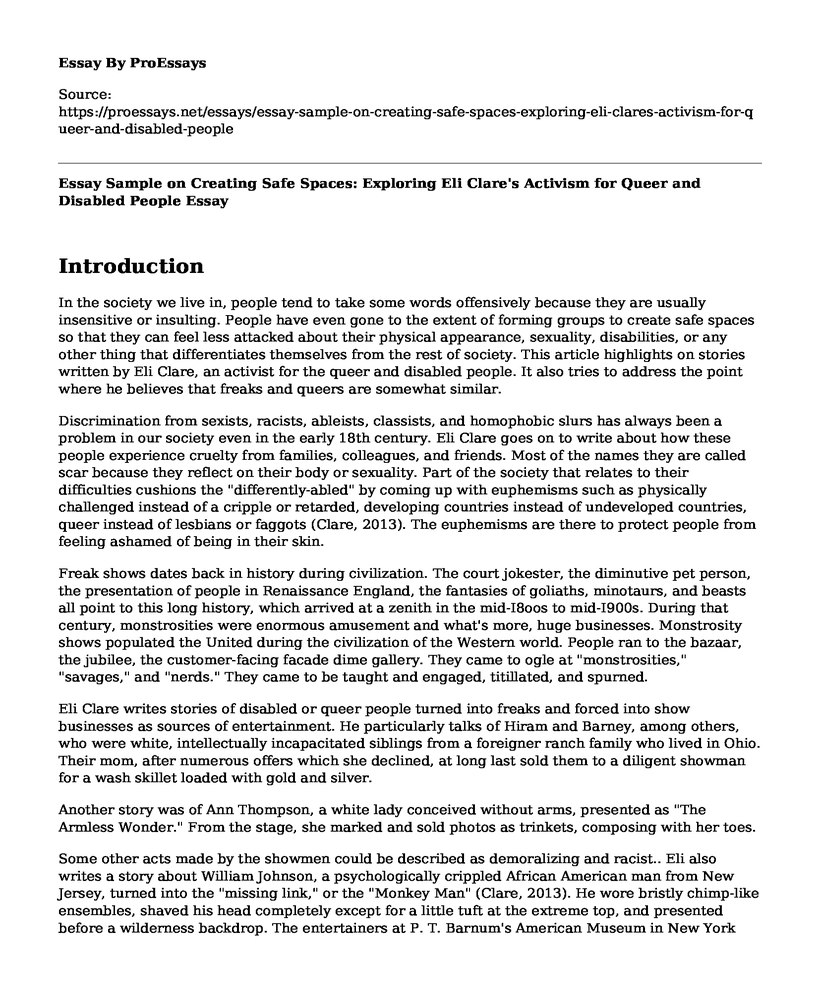Introduction
In the society we live in, people tend to take some words offensively because they are usually insensitive or insulting. People have even gone to the extent of forming groups to create safe spaces so that they can feel less attacked about their physical appearance, sexuality, disabilities, or any other thing that differentiates themselves from the rest of society. This article highlights on stories written by Eli Clare, an activist for the queer and disabled people. It also tries to address the point where he believes that freaks and queers are somewhat similar.
Discrimination from sexists, racists, ableists, classists, and homophobic slurs has always been a problem in our society even in the early 18th century. Eli Clare goes on to write about how these people experience cruelty from families, colleagues, and friends. Most of the names they are called scar because they reflect on their body or sexuality. Part of the society that relates to their difficulties cushions the "differently-abled" by coming up with euphemisms such as physically challenged instead of a cripple or retarded, developing countries instead of undeveloped countries, queer instead of lesbians or faggots (Clare, 2013). The euphemisms are there to protect people from feeling ashamed of being in their skin.
Freak shows dates back in history during civilization. The court jokester, the diminutive pet person, the presentation of people in Renaissance England, the fantasies of goliaths, minotaurs, and beasts all point to this long history, which arrived at a zenith in the mid-I8oos to mid-I900s. During that century, monstrosities were enormous amusement and what's more, huge businesses. Monstrosity shows populated the United during the civilization of the Western world. People ran to the bazaar, the jubilee, the customer-facing facade dime gallery. They came to ogle at "monstrosities," "savages," and "nerds." They came to be taught and engaged, titillated, and spurned.
Eli Clare writes stories of disabled or queer people turned into freaks and forced into show businesses as sources of entertainment. He particularly talks of Hiram and Barney, among others, who were white, intellectually incapacitated siblings from a foreigner ranch family who lived in Ohio. Their mom, after numerous offers which she declined, at long last sold them to a diligent showman for a wash skillet loaded with gold and silver.
Another story was of Ann Thompson, a white lady conceived without arms, presented as "The Armless Wonder." From the stage, she marked and sold photos as trinkets, composing with her toes.
Some other acts made by the showmen could be described as demoralizing and racist.. Eli also writes a story about William Johnson, a psychologically crippled African American man from New Jersey, turned into the "missing link," or the "Monkey Man" (Clare, 2013). He wore bristly chimp-like ensembles, shaved his head completely except for a little tuft at the extreme top, and presented before a wilderness backdrop. The entertainers at P. T. Barnum's American Museum in New York City portrayed William as "an animal, which had attributes of both human and the beast or a blend of both humanity and a savage creation.
Conclusion
In the article written by Eli, he tries to find out what the "freaks" thought of their jobs and lives. He needed to hear their accounts and not the tales from other people. These confessions were instead eaten up, discarded and lost in the everyday routine of endurance. Some of these individuals didn't read or write because of their specific inabilities. A couple of individuals who worked the monstrosity show wrote collections of memoirs. However, these handouts or books were, for the most part, some portion of the entire creation, sold close by the handbills and photographs.
References
Clare, E. (2013). Freaks and queers. Gender and Women's Studies in Canada: Critical Terrain, 145-159. Retrived from: https://books.google.co.ke/books?hl=en&lr=&id=t5PlT9B4CM0C&oi=fnd&pg=PA145&dq=freaks+and+queers+by+Eli+Clare&ots=M6dZfe6rAA&sig=_DQksBpHpnpQDC1QsSmSHKXB358&redir_esc=y#v=onepage&q=freaks%20and%20queers%20by%20Eli%20Clare&f=false
Cite this page
Essay Sample on Creating Safe Spaces: Exploring Eli Clare's Activism for Queer and Disabled People. (2023, Mar 13). Retrieved from https://proessays.net/essays/essay-sample-on-creating-safe-spaces-exploring-eli-clares-activism-for-queer-and-disabled-people
If you are the original author of this essay and no longer wish to have it published on the ProEssays website, please click below to request its removal:
- How Human Trafficking Victims Can Get Help and Treated to Cope With Trauma After Being Rescued
- Stop-and-Frisk Issue in New York Essay
- Comparison of Arbitration and Litigation Essay Example
- Essay Sample on Immigrant Populations: How Social Groups Are Represented in Popular Culture
- Essay Sample on Inequality in America: The Rich vs. Poor Divide
- Essay Example on Abortion Laws: Good and Bad Consequences
- Essay Example on Police Task Forces: Changes, Challenges & Strategies







